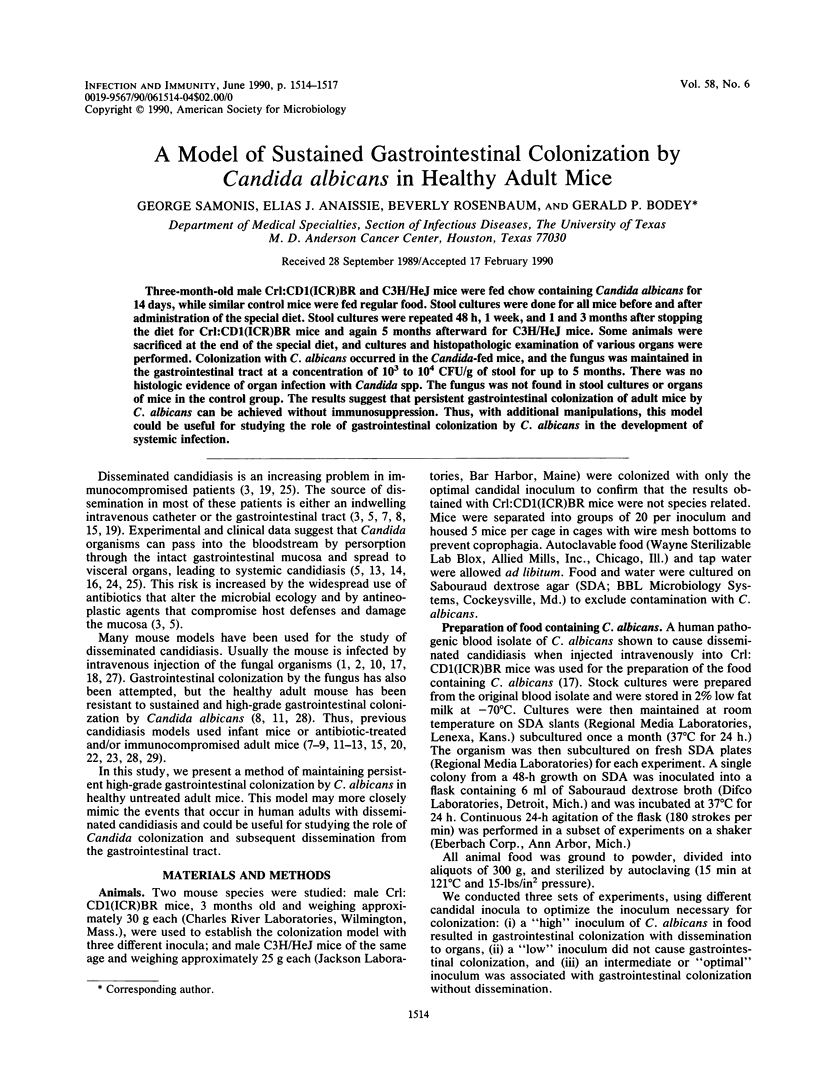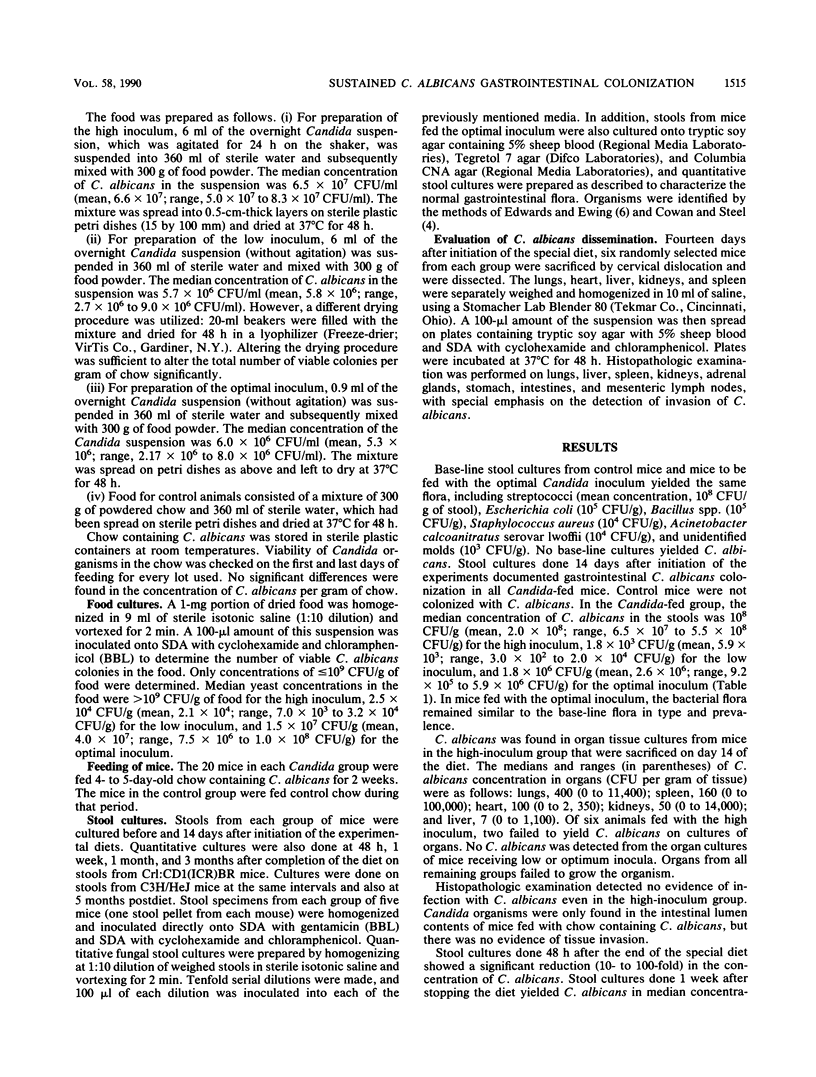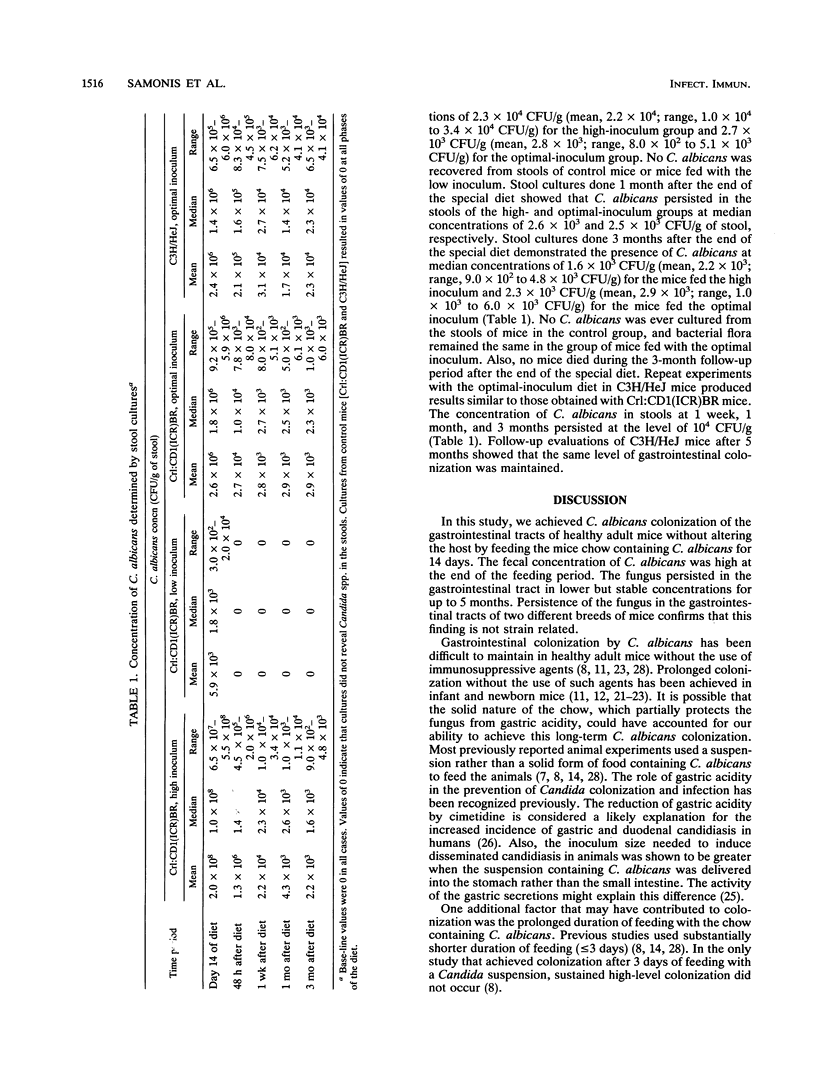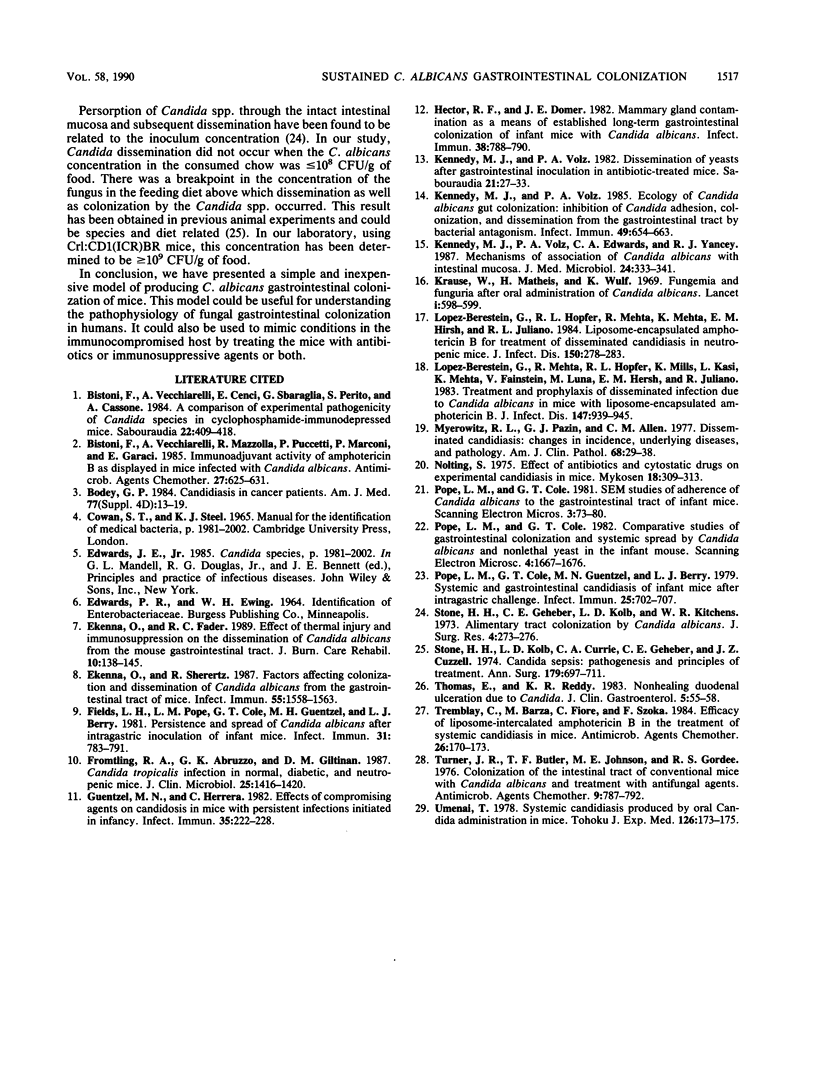Abstract
Three-month-old male Crl:CD1(ICR)BR and C3H/HeJ mice were fed chow containing Candida albicans for 14 days, while similar control mice were fed regular food. Stool cultures were done for all mice before and after administration of the special diet. Stool cultures were repeated 48 h, 1 week, and 1 and 3 months after stopping the diet for Crl:CD1(ICR)BR mice and again 5 months afterward for C3H/HeJ mice. Some animals were sacrificed at the end of the special diet, and cultures and histopathologic examination of various organs were performed. Colonization with C. albicans occurred in the Candida-fed mice, and the fungus was maintained in the gastrointestinal tract at a concentration of 10(3) to 10(4) CFU/g of stool for up to 5 months. There was no histologic evidence of organ infection with Candida spp. The fungus was not found in stool cultures or organs of mice in the control group. The results suggest that persistent gastrointestinal colonization of adult mice by C. albicans can be achieved without immunosuppression. Thus, with additional manipulations, this model could be useful for studying the role of gastrointestinal colonization by C. albicans in the development of systemic infection.
Full text
PDF



Selected References
These references are in PubMed. This may not be the complete list of references from this article.
- Bistoni F., Vecchiarelli A., Cenci E., Sbaraglia G., Perito S., Cassone A. A comparison of experimental pathogenicity of Candida species in cyclophosphamide-immunodepressed mice. Sabouraudia. 1984;22(5):409–418. doi: 10.1080/00362178485380661. [DOI] [PubMed] [Google Scholar]
- Bistoni F., Vecchiarelli A., Mazzolla R., Puccetti P., Marconi P., Garaci E. Immunoadjuvant activity of amphotericin B as displayed in mice infected with Candida albicans. Antimicrob Agents Chemother. 1985 Apr;27(4):625–631. doi: 10.1128/aac.27.4.625. [DOI] [PMC free article] [PubMed] [Google Scholar]
- Bodey G. P. Candidiasis in cancer patients. Am J Med. 1984 Oct 30;77(4D):13–19. [PubMed] [Google Scholar]
- Ekenna O., Fader R. C. Effect of thermal injury and immunosuppression on the dissemination of Candida albicans from the mouse gastrointestinal tract. J Burn Care Rehabil. 1989 Mar-Apr;10(2):138–145. doi: 10.1097/00004630-198903000-00007. [DOI] [PubMed] [Google Scholar]
- Ekenna O., Sherertz R. J. Factors affecting colonization and dissemination of Candida albicans from the gastrointestinal tract of mice. Infect Immun. 1987 Jul;55(7):1558–1563. doi: 10.1128/iai.55.7.1558-1563.1987. [DOI] [PMC free article] [PubMed] [Google Scholar]
- Field L. H., Pope L. M., Cole G. T., Guentzel M. N., Berry L. J. Persistence and spread of Candida albicans after intragastric inoculation of infant mice. Infect Immun. 1981 Feb;31(2):783–791. doi: 10.1128/iai.31.2.783-791.1981. [DOI] [PMC free article] [PubMed] [Google Scholar]
- Fromtling R. A., Abruzzo G. K., Giltinan D. M. Candida tropicalis infection in normal, diabetic, and neutropenic mice. J Clin Microbiol. 1987 Aug;25(8):1416–1420. doi: 10.1128/jcm.25.8.1416-1420.1987. [DOI] [PMC free article] [PubMed] [Google Scholar]
- Guentzel M. N., Herrera C. Effects of compromising agents on candidosis in mice with persistent infections initiated in infancy. Infect Immun. 1982 Jan;35(1):222–228. doi: 10.1128/iai.35.1.222-228.1982. [DOI] [PMC free article] [PubMed] [Google Scholar]
- Hector R. F., Domer J. E. Mammary gland contamination as a means of establishing long-term gastrointestinal colonization of infant mice with Candida albicans. Infect Immun. 1982 Nov;38(2):788–790. doi: 10.1128/iai.38.2.788-790.1982. [DOI] [PMC free article] [PubMed] [Google Scholar]
- Kennedy M. J., Volz P. A. Dissemination of yeasts after gastrointestinal inoculation in antibiotic-treated mice. Sabouraudia. 1983 Mar;21(1):27–33. doi: 10.1080/00362178385380051. [DOI] [PubMed] [Google Scholar]
- Kennedy M. J., Volz P. A. Ecology of Candida albicans gut colonization: inhibition of Candida adhesion, colonization, and dissemination from the gastrointestinal tract by bacterial antagonism. Infect Immun. 1985 Sep;49(3):654–663. doi: 10.1128/iai.49.3.654-663.1985. [DOI] [PMC free article] [PubMed] [Google Scholar]
- Kennedy M. J., Volz P. A., Edwards C. A., Yancey R. J. Mechanisms of association of Candida albicans with intestinal mucosa. J Med Microbiol. 1987 Dec;24(4):333–341. doi: 10.1099/00222615-24-4-333. [DOI] [PubMed] [Google Scholar]
- Krause W., Matheis H., Wulf K. Fungaemia and funguria after oral administration of Candida albicans. Lancet. 1969 Mar 22;1(7595):598–599. doi: 10.1016/s0140-6736(69)91534-7. [DOI] [PubMed] [Google Scholar]
- Lopez-Berestein G., Hopfer R. L., Mehta R., Mehta K., Hersh E. M., Juliano R. L. Liposome-encapsulated amphotericin B for treatment of disseminated candidiasis in neutropenic mice. J Infect Dis. 1984 Aug;150(2):278–283. doi: 10.1093/infdis/150.2.278. [DOI] [PubMed] [Google Scholar]
- Lopez-Berestein G., Mehta R., Hopfer R. L., Mills K., Kasi L., Mehta K., Fainstein V., Luna M., Hersh E. M., Juliano R. Treatment and prophylaxis of disseminated infection due to Candida albicans in mice with liposome-encapsulated amphotericin B. J Infect Dis. 1983 May;147(5):939–945. doi: 10.1093/infdis/147.5.939. [DOI] [PubMed] [Google Scholar]
- Myerowitz R. L., Pazin G. J., Allen C. M. Disseminated candidiasis. Changes in incidence, underlying diseases, and pathology. Am J Clin Pathol. 1977 Jul;68(1):29–38. doi: 10.1093/ajcp/68.1.29. [DOI] [PubMed] [Google Scholar]
- Nolting S., Fegeler K., Koralewski F., Ludwig G. Einfluss von Antibiotika und Cytostatika auf die experimentelle Candidose der Maus. Mykosen. 1975 Jul;18(7):309–313. [PubMed] [Google Scholar]
- Pope L. M., Cole G. T. Comparative studies of gastrointestinal colonization and systemic spread by Candida albicans and nonlethal yeast in the infant mouse. Scan Electron Microsc. 1982;(Pt 4):1667–1676. [PubMed] [Google Scholar]
- Pope L. M., Cole G. T., Guentzel M. N., Berry L. J. Systemic and gastrointestinal candidiasis of infant mice after intragastric challenge. Infect Immun. 1979 Aug;25(2):702–707. doi: 10.1128/iai.25.2.702-707.1979. [DOI] [PMC free article] [PubMed] [Google Scholar]
- Pope L. M., Cole G. T. SEM studies of adherence of candida albicans to the gastrointestinal tract of infant mice. Scan Electron Microsc. 1981;(Pt 3):73–80. [PubMed] [Google Scholar]
- Stone H. H., Geheber C. E., Kolb L. D., Kitchens W. R. Alimentary tract colonization by Candida albicans. J Surg Res. 1973 Apr;14(4):273–276. doi: 10.1016/0022-4804(73)90028-0. [DOI] [PubMed] [Google Scholar]
- Stone H. H., Kolb L. D., Currie C. A., Geheber C. E., Cuzzell J. Z. Candida sepsis: pathogenesis and principles of treatments. Ann Surg. 1974 May;179(5):697–711. doi: 10.1097/00000658-197405000-00024. [DOI] [PMC free article] [PubMed] [Google Scholar]
- Thomas E., Reddy K. R. Nonhealing duodenal ulceration due to candida. J Clin Gastroenterol. 1983 Feb;5(1):55–58. doi: 10.1097/00004836-198302000-00012. [DOI] [PubMed] [Google Scholar]
- Tremblay C., Barza M., Fiore C., Szoka F. Efficacy of liposome-intercalated amphotericin B in the treatment of systemic candidiasis in mice. Antimicrob Agents Chemother. 1984 Aug;26(2):170–173. doi: 10.1128/aac.26.2.170. [DOI] [PMC free article] [PubMed] [Google Scholar]
- Turner J. R., Butler T. F., Johnson M. E., Gordee R. S. Colonization of the intestinal tract of conventional mice with Candida albicans and treatment with antifungal agents. Antimicrob Agents Chemother. 1976 May;9(5):787–792. doi: 10.1128/aac.9.5.787. [DOI] [PMC free article] [PubMed] [Google Scholar]
- Umenai T. Systemic candidiasis produced by oral Candida administration in mice. Tohoku J Exp Med. 1978 Oct;126(2):173–175. doi: 10.1620/tjem.126.173. [DOI] [PubMed] [Google Scholar]


